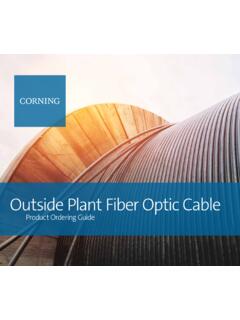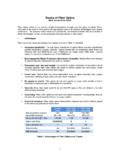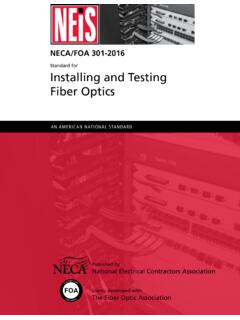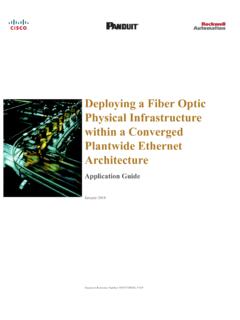Transcription of Installation - Optical Cable Corporation
1 OCC-206-3 Installation Conduit Guidelines Excerpt from Optical Cable Corporation s Installation GUIDE CONTROLLED DOCUMENT OCC-206-3 Rev. A 8 April 2008 Installation Conduit Guidelines Excerpt from Optical Cable Corporation s Installation Guide Page 2 of 6 OCC-206-3 CONTROLLED DOCUMENT Rev. A 8 April 2008 Conduit Installation A conduit Cable Installation involves placement of one or more Optical cables inside a preinstalled conduit that runs between access points. Access points can be as large as a manhole vault or small as a hand hole.
2 Conduit Installation can consist of newly installed conduits or pre-existing conduits. New conduits should be installed in as straight path as possible. Existing conduits typically require maintenance prior to installing a Cable . Conduits can be installed in direct buried applications, backbone distribution systems, horizontal distribution systems, or aerial applications. Aerial conduit can reduce Cable cost by eliminating the need to use aerial fiber optic cables when aerial crossings are necessary. Aerial conduits also provide Cable protection against rodents, projectile objects, such as rocks and gun pellets, and harsh weather conditions. They can be used to cross highways, water, wooded areas, or any location where direct buried conduit is not a viable option. Precautions Prior to Installing Cable Temperatures Installation & Operation Installation and operating temperatures for indoor and indoor/outdoor fiber optic cables are defined in standards ICEA S-83-596 Standard for Optical Fiber Premises Distribution Cable and ICEA S-104-696 Standard for Indoor-Outdoor Optical Fiber Cable , respectively.
3 The temperatures listed in the ICEA documents are minimum temperature ranges for these cables types. Some Cable types, based upon the manufacturer, may be able to be installed and operate at different temperatures. Please consult the Cable manufacturer. In cold weather installations, it is recommended that fiber optic cables be stored in a heated storage area at least twenty four hours prior to Cable Installation . Clearing Conduits Using a plug approximately the same diameter as the inside of the conduit, clear all burrs and obstructions in the conduit by pulling the plug through the structure. Follow with a wire brush and swab to clean and remove foreign matter from the conduit. Smooth, burr-free conduit interiors are important in preventing abrasion damage to the Cable jacket during pulling. Cable Twist Fiber optic cables should never be subjected to excessive twist.
4 Excessive twist in the Cable causes bending stress in the fibers, resulting in increased attenuation. During a conduit Installation , a breakaway swivel should always be used to attach the pull rope to the Cable in order to prevent twisting. Please refer to the Installation General Guidelines of the Optical Cable Corporation Installation Guide. Pulling Lubricants Friction between the outer jacket of the Cable and the conduit creates unwanted tension on the Cable while pulling the Cable through the conduit. Proper Cable lubrication is designed to reduce the tension on the fiber optic Cable . The recommended amount of lubricant is dependent on the size and length of the conduit system as well as the jacketing and conduit material in which the Cable is being pulled into.
5 The following equation can predict a satisfactory quantity of lubricant need for an average pull. Q = x L x D Where: Q = quantity needed in gallons L = length of pull in feet D = nominal inside diameter of conduit in inches Quantity of lubricant for complex pulls, old/dirty conduits, high conduit fill ratio, several bends, increases in elevation, and high temperatures may require an increase Installation Conduit Guidelines Excerpt from Optical Cable Corporation s Installation Guide Page 3 of 6 OCC-206-3 CONTROLLED DOCUMENT Rev. A 8 April 2008 in lubricant up to 50% more than the prediction listed above.
6 It is recommended that water based lubricants be used for all Cable outer jackets or lubricants that match the Cable jacket type. Conduit Capacity For fiber optic cables , the National Electric Code (NEC) conduit fill tables apply only when the cables have metallic members or are placed in conduits with electrical power cables. Please refer to the NEC handbook for the conduit fill tables. For non NEC applicable installations, TIA/EIA-569-B Commercial Building Standard for Telecommunications Pathways and Spaces provides guidelines on Cable capacity for conduits ranging from 16 mm (1/2 trade size) to 103 mm (4 trade size). Table 9 of the standard lists the conduit sizing for horizontal cables and Tables 10 and 11 lists the conduit fill ratio for backbone cables.
7 However, the number of cables that can be installed is limited by the maximum pulling tensions of the cables. Please refer to TIA/EIA-569-B Commercial Building Standard for Telecommunications Pathways and Spaces for more information. To calculate fill ratio for a single Cable in a conduit, the following equation can be used. Fill Ratio = d2/D2 Where: d = outside diameter of Cable D = inside diameter of conduit For multiple cables, the following equation can be used. Fill Ratio = d12 + d22 + .. + dn2 D2 Pull Lengths and Bends For horizontal distribution systems, TIA/EIA-569-B Commercial Building Standard for Telecommunications Pathways and Spaces states that no section of conduit will be longer than 30 m (100 ft) between pull points. The standard also states that no section of conduit will have more than two 90-degree bends, or equivalent, between pull points.
8 For backbone distribution systems, TIA-758-A Customer-owned Outside Plant Telecommunications Infrastructure Standard states that no section of conduit will be longer than 183 m (600 ft) between pull points. The standard also states that no section of conduit will have more that two 90-degree bends, or equivalent, between pull points. Please refer to TIA/EIA-569-B Commercial Building Standard for Telecommunications Pathways and Spaces and TIA-758-A Customer-owned Outside Plant Telecommunications Infrastructure Standard for more information. Estimating Pulling Tensions Depending on the route layout, it may be necessary to estimate the pulling tensions prior to installing the Cable . One key parameter in tension calculations is the coefficient of friction.
9 The friction coefficient depends on the fiber optic Cable jacket material, the conduit type, and the pulling lubricant type (if used). The lubricant manufacturers should provide friction coefficients necessary for the calculations. Once the friction coefficient has been determined, the pulling tensions can be calculated by using the following simplified formulas. Straight Pull: Tout = Tin + (W)(K)(L) Horizontal Bend: Tout = Tin(eK ) Where: Tout = Tension Exiting Pull Section Tin = Tension Entering Pull Section W = Weight of Cable (s) K = Coefficient of Friction = Angle of Bend (radians) The calculations must be done in sections. Straight pulls and horizontal bends must be calculated separately. For example, if a route consists of twenty feet of straight conduit and then a ninety degree bend, the straight section would be calculated first using the back tension of the reel as the Tin.
10 The ninety degree bend would then be calculated using the Tout of the straight section as Tin for the bend section calculation. Installation Conduit Guidelines Excerpt from Optical Cable Corporation s Installation Guide Page 4 of 6 OCC-206-3 CONTROLLED DOCUMENT Rev. A 8 April 2008 Please note that these are simplified equations. More complex equations include weight correction factors for multiple Cable pulls and gravitational corrections for non-horizontal conduit sections and bends. Pulling software may be required for complex tension calculations.






